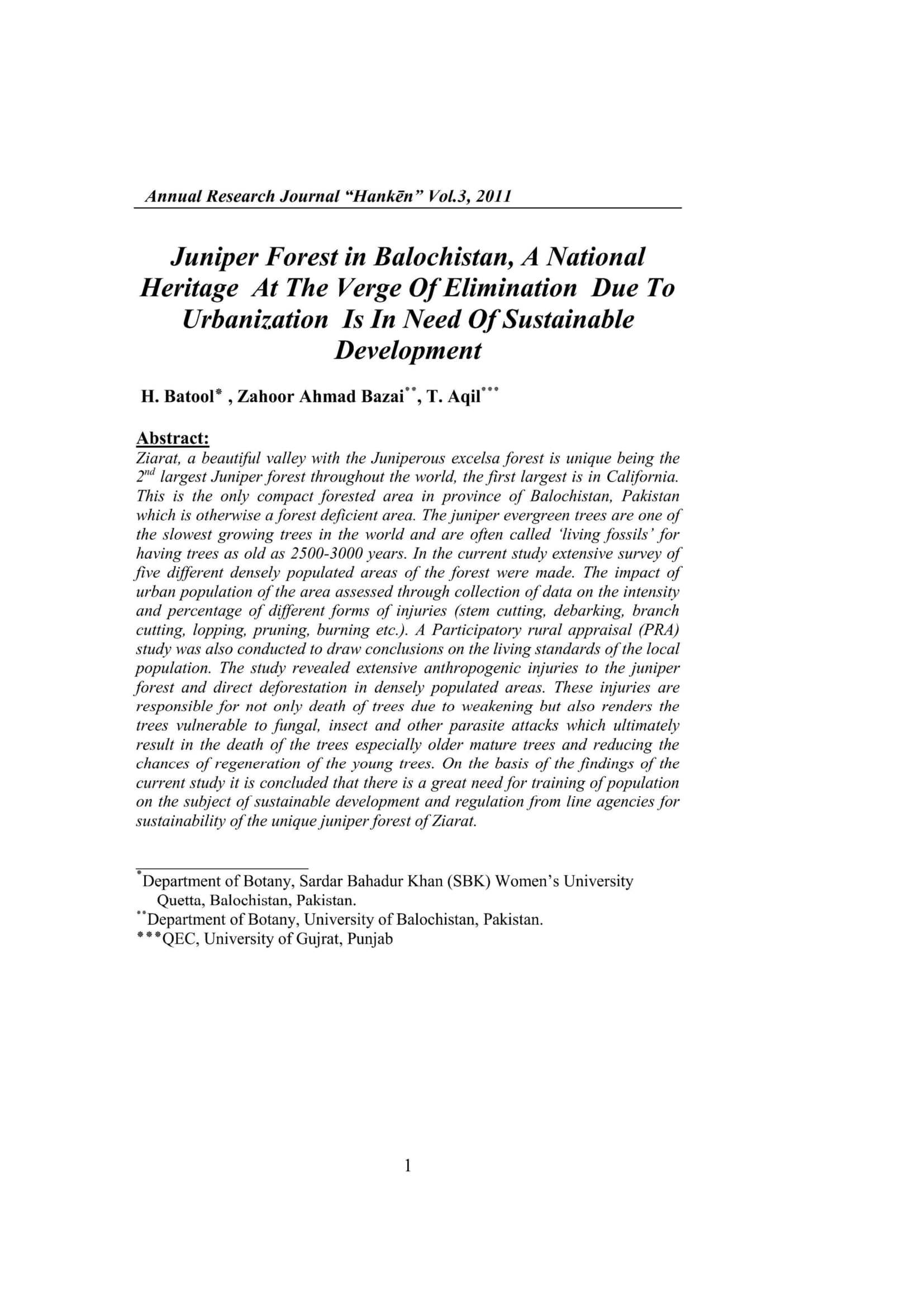Juniper Forest in Balochistan, A National Heritage At The Verge Of Elimination Due To Urbanization Is In Need Of Sustainable Development
Keywords:
Sustainable development, Juiperus excelsa, anthropogenic, Participatory Rural Appraisal.Abstract
Ziarat, a beautiful valley with the Juniperous excelsa forest is unique being the 2nd largest Juniper forest throughout the world, the first largest is in California. This is the only compact forested area in province of Balochistan, Pakistan which is otherwise a forest deficient area. The juniper evergreen trees are one of the slowest growing trees in the world and are often called ‘living fossils’ for having trees as old as 2500-3000 years. In the current study extensive survey of five different densely populated areas of the forest were made. The impact of urban population of the area assessed through collection of data on the intensity and percentage of different forms of injuries (stem cutting, debarking, branch cutting, lopping, pruning, burning etc.). A Participatory rural appraisal (PRA) study was also conducted to draw conclusions on the living standards of the local population. The study revealed extensive anthropogenic injuries to the juniper forest and direct deforestation in densely populated areas. These injuries are responsible for not only death of trees due to weakening but also renders the trees vulnerable to fungal, insect and other parasite attacks which ultimately result in the death of the trees especially older mature trees and reducing the chances of regeneration of the young trees. On the basis of the findings of the current study it is concluded that there is a great need for training of population on the subject of sustainable development and regulation from line agencies for sustainability of the unique juniper forest of Ziarat.
References
Anonymous: "Logging is the Major Cause of Global Deforestation – New WWF Report." World Wide Rainforest Report #33 – Logging and Deforestation. http://forests.org/ric/wrr33/wwf.htm (22 Feb. 1998).
Bazai Z. A., S. A. Kayani, R. B. Tareen, and K. M. Kakar,. 2006. “Diversity and Community Characteristicsof Juniper Forest at Ziarat, BalochistanPakistan”.Editors:H.N.PandayandS.K.Barik,‘Ecology,Diversiy and Conservation of Plants and Ecosystems in India, Regency Publications, New Delhi,India, pp. 101-109.
Champion, H. G., S. K. Seth, and G. M. Khattak (1965). Forest types of Pakistan. P.F.I. Peshawar,Pakistan.
Gábor M., V. Gyuricza J. Bernáth and V. Altbacker,. 2008. “Essential Oil Yield and Composition Reflect Browsing Damage of Junipers”, Journal of Chemical Ecology, Springer Netherlands 2008. V-34,12, pp. 1545-1552Mukherjee, N. 1994. “Participatory Rural Appraisal Methodology and Applications” 2rd edition, Ashok Kumar Concept Publising Company, New Delhi India, 30pp.
Musakhe M. Y., A. Jabbar, R. B. Tareen and Z. A. Bazai. 2007. “An Evaluation Study of Impact of Fuel Efficient Stove on Juniper (Juniperus excelsa) Tract, Balochistan”. INT. J. BIOL. BIOTECH., 4 (1): 51-55.
Rao. A. L. (1991).A Preliminary study on JuniperEcosysteminBalochistanPakistan. pp. 9-31 and 40-41.
Steel, R.G.D. and J.H. Torrie. 1980. “Principles and Procedure of Statistics”. McGraw Hill Book Co. Inc. New York. 507pp.


